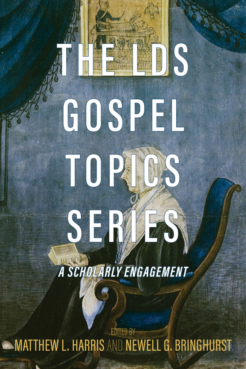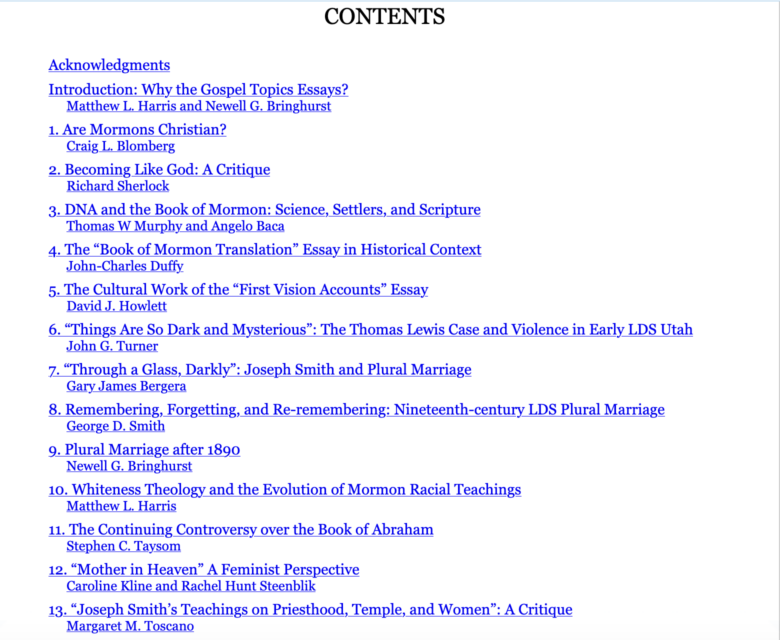
 When the Gospel Topics essays began to quietly appear seven years ago on the website of the Church of Jesus Christ of Latter-day Saints, I learned about them only because of the job I have and the nerdy historian friends I keep. A couple of people I know were involved in the process of creating these official answers to members’ thorniest historical and theological questions about our faith.
When the Gospel Topics essays began to quietly appear seven years ago on the website of the Church of Jesus Christ of Latter-day Saints, I learned about them only because of the job I have and the nerdy historian friends I keep. A couple of people I know were involved in the process of creating these official answers to members’ thorniest historical and theological questions about our faith.
Everything was sub rosa—not just the historians’ work, but even, when the essays began to be published in November of 2013, the final product. The essays were not mentioned at church or General Conference; there was no splashy article in the Ensign when they debuted; there was no Public Affairs statement explaining their purpose or even acknowledging their existence.
Rather, they had what Elder Steven Snow later called a “soft roll out,” aiming to answer the hard gospel questions of people who wanted to know more about controversial topics like polygamy or different versions of Joseph Smith’s First Vision while not throwing “everything weird” about church history at those who were not already explicitly seeking that information. While 90% of members were not troubled by questions about things like the Book of Abraham, Snow said that “yet we had a lot of people struggling with some of these issues. We were losing young people particularly.”
So for that minority, the church created the Gospel Topics essays, and for the longest time didn’t even make it clear that they had been approved by the Quorum of the Twelve and the First Presidency. (That has since been corrected, after some members and even local bishops believed that the essays were anti-Mormon propaganda.)
I’ve yet to hear ordinary folks at church discuss the essays, and I’d be willing to wager that many still don’t know of their existence, but they are slowly making their way into official discourse and the church’s recently refreshed curriculum.
And now, for the first time, there is a resource to help ordinary members understand the essays—what they say (which is often a leap forward in the church’s transparency about its history) and, just as importantly, what they don’t say (which is often a lot). The Gospel Topics Essays: A Scholarly Engagement is the first book I’m aware of to tackle the essays head on, analyzing their strengths and weaknesses.
Editors Matthew L. Harris (fresh off his just-published political biography of Ezra Taft Benson, which RNS profiled here earlier this month) and Newell G. Bringhurst have brought together 13 top scholarly voices for the 13 essays, covering topics that range from theology to nineteenth-century history to gender studies. I’m making my way through the book right now, and some of the content is superb. I have my quibbles (why are all three essays on polygamy written by men?), but many of the individual essays shine.
 This is not a collection that I’d give to more conservative members of the Church who have, for example, just stumbled onto the CES Letter for the first time and are encountering some of these problems in church history for the first time. It’s already overwhelming for people to take in that there’s no compelling DNA evidence to support the church’s traditional theory of Book of Mormon peoples, for example, or that Joseph Smith’s plural wives included women who were already married to other men. That’s a lot.
This is not a collection that I’d give to more conservative members of the Church who have, for example, just stumbled onto the CES Letter for the first time and are encountering some of these problems in church history for the first time. It’s already overwhelming for people to take in that there’s no compelling DNA evidence to support the church’s traditional theory of Book of Mormon peoples, for example, or that Joseph Smith’s plural wives included women who were already married to other men. That’s a lot.
Rather, I’d give this book to people who already know those basic facts and are ready to go deeper in trying to make sense of them. One theme that ties these essays together is that while the Gospel Topics essays evince a refreshing frankness about church history that has surprised many readers, they’re actually far more restrained and conservative than they could have been.
John-Charles Duffy makes this point in his chapter on controversies about the translation of the Book of Mormon. Many people expressed surprise that the Gospel Topics essay “Book of Mormon Translation” candidly admitted that most historical accounts of translation indicate that Joseph Smith didn’t translate the plates while actually looking at the plates. In our church lessons and manuals for many years, we’ve seen images of a studious-looking young Joseph poring over the plates, trying to decipher their meaning. The reality, as the essay makes clear, is that he “placed either the interpreters or the seer stone in a hat, pressed his face into the hat to block out extraneous light, and read aloud the English words that appeared on the instrument.”
Duffy writes:
“For forthrightly addressing problematic historical information that might instead have been swept under the rug, the Gospel Topics essay may seem progressive. In a larger picture, however, the essay is significant not because it is progressive but because it is markedly conservative even by LDS standards. . . . It was not inevitable that the Gospel Topics essay would assert the particular scenario it did for how the Book of Mormon was translated—namely, that Smith read the English translation from the interpretive instruments.”
According to Duffy, the decision to state that Smith read the English is actually controversial in that it puts forward a Book of Mormon that is essentially inerrant, verbatim, just recited by Smith with no involvement on Smith’s part.
This rejects an earlier view that was in the curriculum a century ago as taught by B. H. Roberts, in which Smith had a larger part to play than as a mouthpiece for an English text he received in full. By making Smith a more active participant in choosing the words to describe the impressions he received from God, Roberts offered a way for the church to sidestep serious questions about, for example, anachronistic language in the book (why is there iron? Why are there horses?) and the many grammatical errors of the initial translation.
Those errors were Smith’s, not God’s, according to Roberts. But by definitively rejecting Roberts’s view in favor of the “read English translation,” Duffy says, the church has newly backed itself into a corner of literalism—which is not the way to persuade doubters.
I would never have known that fascinating bit of history, and the whole anthology is full of such observations: where the Gospel Topics essays are concerned, there are many theological and historical roads not taken. And if the essays ever truly find themselves in public discussion, maybe we can start talking about those other possibilities as well as (finally!) the essays themselves.
Related content:
- Every Mormon leader (and teacher, and parent) should read this book
- Staying Mormon: “Planted” with Patrick Mason
- In a Mormon faith transition? Here’s help
